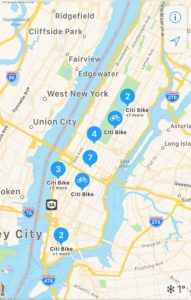
Bike-sharing locations for 179 cities now available on Apple Maps

Struggling to keep up with your fitness goals for 2018? A new feature in Apple Maps can help you with that!
Apple has partnered with Ito World to incorporate the latter’s global bike sharing dataset into its Maps product. The locations of bikes and docking stations for 179 cities in 36 countries are now searchable on Apple Maps. Of these 179 cities, 176 have a bike sharing system in place. Which means if you want to go biking in a new city, all you have to do is type the phrase ‘bike sharing’ in Apple Maps search tab and you will be able to see the locations of both public and private bike operators. The results closest to you will be labeled with a tag called ‘nearby’, easily distinguishing themselves.
 According to Ito World, its bike share data feed automatically standardizes and consolidates public bike share data from a number of global operators, keeping quality assurance in mind. But the information which is relevant to bikes, and is not a part of this feed, is: How many bikes are available at a particular station? After all, there’s no use going to the nearest result location if that place doesn’t have any bikes to rent out.
According to Ito World, its bike share data feed automatically standardizes and consolidates public bike share data from a number of global operators, keeping quality assurance in mind. But the information which is relevant to bikes, and is not a part of this feed, is: How many bikes are available at a particular station? After all, there’s no use going to the nearest result location if that place doesn’t have any bikes to rent out.
Hopefully, Apple will find a way to add this data to the results in the near future. Because until then, local commuters may find it easier to use specialized apps like Mobike or oBike. That said, it’s good to see Apple trying to keep up with the Joneses (read Google Maps) with useful information-based features like this. However, going by the pace of recent developments at Google Maps, Apple has its work cut out for itself. Here’s a sample:
How Google Maps is using machine learning to ease our parking woes
Google Maps gets a color-coded makeover for enhanced location discovery
Google Maps now lets you save location of your parking spot
How to get real-time, personalized info on Google Maps
Google Maps gives shortcuts to bikers with Motorcycle Mode in India







